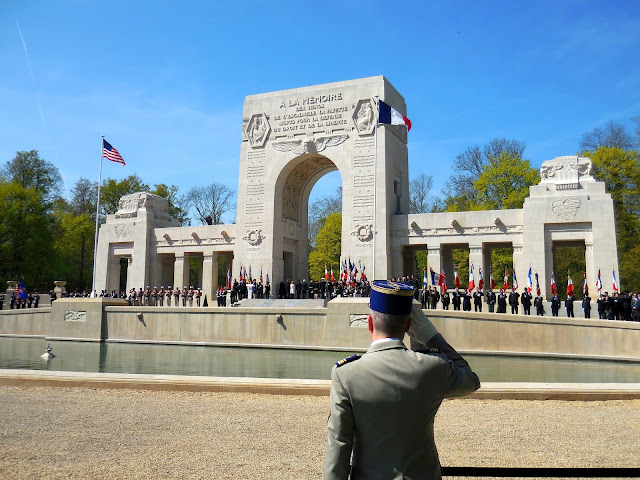April 20, 2016 was the 100th anniversary of the
founding of the United States Air Force.
Ceremonies marking the occasion were conducted at a beautiful memorial
west of Paris dedicated to the Lafayette Escadrille, an American flying
squadron formed in World I to fly with the French.
The beginning for Americans flying in combat started with
some young American men who were living in Paris when World War I broke out. They felt compelled to “enter the fray”
on the side of France, an old American ally going back to the Revolutionary
War. They were advised at the
time, in 1916, that the United States was still technically a “neutral” in the
First World War. That did
not deter them. They joined
the French Foreign Legion, began their flight training under French command, and
soon were engaged in aerial combat with the Germans over the trenches east of
Paris. They took the name
“Lafayette” from the French General who had been part of George Washington’s
Continental Army. Their logo,
painted on their planes, was an American Sioux Indian headdress.
It was a risky time in military aviation. Airplanes were new and aerial combat
untested. A year later (1917),
when the United States entered the war, they would be attached directly to the
U.S. Army which had established its own Air Service command. Before the war ended on November 11,
1918 many of these flyers had been killed. At war’s end, a French foundation supported by private
philanthropy from the United States, built a Memorial to these earliest
American combat flyers. 38
American pilots are buried there in a sarcophagus beneath a Memorial
reminiscent of the Arch D’ Triumph.
 |
| French Fighter Jet Formation over Lafayette Escadrille. Lead aircraft painted American red, white and blue. |
Last month, on April 20th, United States and French air power came in force to remember these pioneers of military aviation. There was a fly-by of jet fighters and, at the end of the ceremony, a B-52 bomber flew over the site. It almost defies logic that something as historic and mammoth as the U.S. Air Force could have such humble beginnings: a small group of dedicated American volunteers banded together to fly for what they believed to be the just cause of an American ally.
Over the past three years, the American Battle Monuments Commission, supervised a renovation of the Lafayette Escadrille Memorial. After the ceremony, the commission voted to make the Memorial an integral part of the American memorials and cemeteries where our overseas war dead are buried. As one of our commissioners, an Air Force veteran, said with great emotion when the vote was taken: “Now, we have brought our boys home.”
Over the past three years, the American Battle Monuments Commission, supervised a renovation of the Lafayette Escadrille Memorial. After the ceremony, the commission voted to make the Memorial an integral part of the American memorials and cemeteries where our overseas war dead are buried. As one of our commissioners, an Air Force veteran, said with great emotion when the vote was taken: “Now, we have brought our boys home.”
 |
| Lafayette Escadrille Memorial Re-Dedication, April 20, 2016 |
Though the young men who died fighting in skies of France in
World War I faced fear and death, I have never known any pilot who did not
first love and appreciate the beauty of flying and the thrill of being in the
sky. 25 years later, in World War
II, another American pilot similarly volunteered and died flying Spitfires for
the British Royal Air Force. Prior to his death, John Gillespie Mcgee
Jr. wrote this poem which he sent to his parents
“Oh!
I have slipped the surly bonds of Earth
And
danced the skies on laughter-silvered wings:
Sunward
I’ve climbed, and joined the tumbling mirth
Of
sun-split clouds—and done a hundred things
You
have not dreamed of—wheeled and soared and swung
High
in the sunlit silence. Hov’ring
there,
I’ve
chased the shouting wind, and flung
My
eager craft through footless halls of air….
Up,
up the long, delirious burning blue
I’ve
topped the wind-swept heights with easy grace
Where
never lark, or even eagle flew—
And,
while with silent, lifting mind I’ve trod
The
high untrespassed sanctity of space,
Put
out my hand, and touched the face of God.”
As with those buried at the Lafayette Escadrille Memorial, John Gillespie Magee, Jr. was a young man. He was nineteen years old when he died.
Rolland Kidder
Stow, NY
Commissioner, American Battle Monuments Commission
Photos
courtesy of the French Ministère de la Défense
